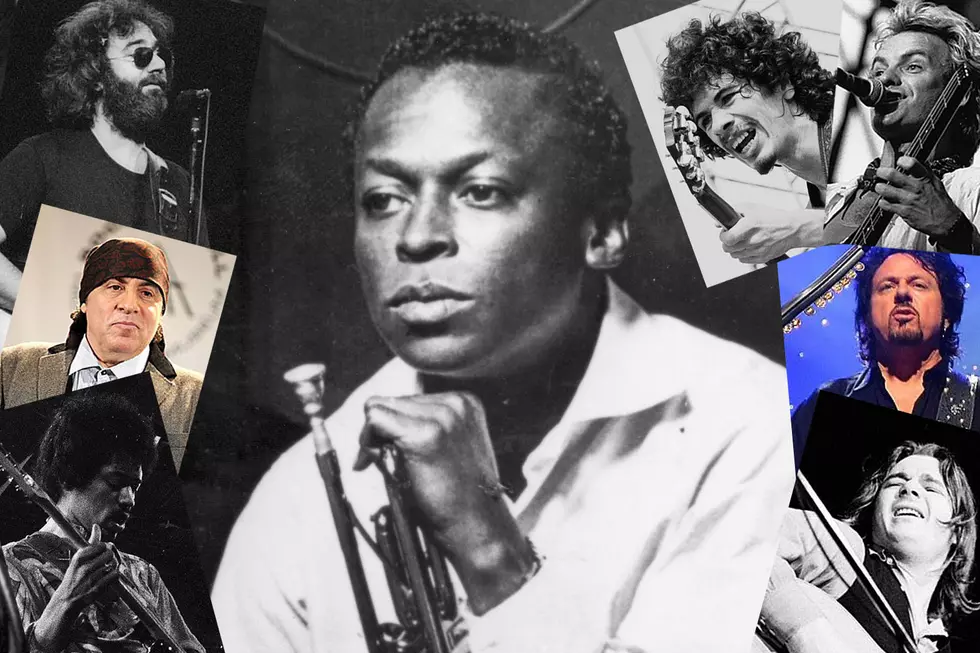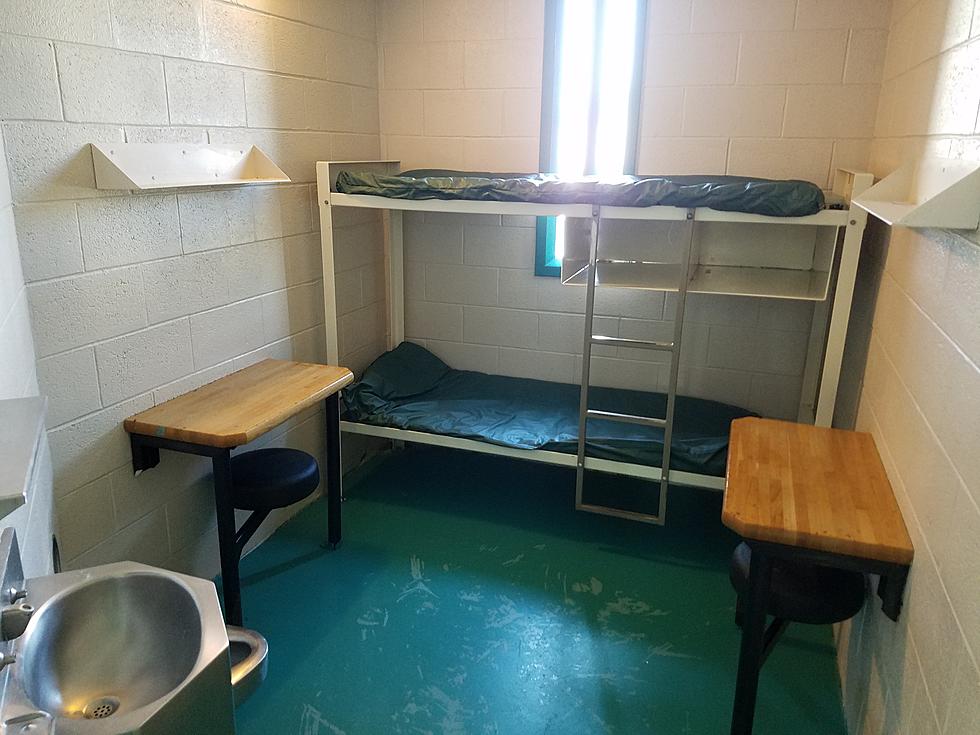
Miles Davis’ Rock ‘n’ Roll Connections
Jack Johnson arrived on Feb. 24, 1971, as perhaps Miles Davis' most overtly rock-influenced album. After all, he started the sessions fronting the classic stadium-stage lineup of bass, guitar and drums.
His connection to the genre, however, went much deeper – and continued for many years.
Davis began adding electric instruments and other sounds more associated with rock 'n' roll early as the Circle in the Round sessions from 1967. Over the next decade, he'd continue to radically re-envision his music, adding elements of funk, world music, R&B and ambient while pulling off one genre-bending, mind-blowing experiment after another.
"Everything was experimentation," drummer Billy Cobham later told Jazzwise. "There was not one moment that whatever was put on a piece of paper would not be changed."
Rock musicians met him halfway, sitting in on sessions with Davis, sharing huge concert stages and grafting his risk-taking approach into their own projects. Davis played the Isle of Wight Festival, for instance, on a bill that included the Who, the Doors, Chicago and Jimi Hendrix, among others. Cobham later collaborated with Deep Purple guitarist Tommy Bolin.
The launching pad was a series of opening dates at the Fillmore in 1970, where Davis found common ground with Neil Young, Grateful Dead and crowds of a very different sort. "I think we all learned something," Davis wrote in his autobiography. "Jerry Garcia loved jazz, and I found out that he loved my music and had been listening to it for a long time."
He'd later costar on early-'70s festival dates with Creedence Clearwater Revival, the James Gang, the Band, Santana and Steppenwolf; a planned Louisiana event was to pair Davis with the Beach Boys and Pink Floyd before being downsized due to local opposition. At some point, however, the ever-restless Davis grew bored with hanging out with rockers, moving away from the practice until the late '80s.
Here's a look back at Miles Davis' rock 'n' roll connections.
JIMI HENDRIX (1969): Davis perhaps inevitably found his way to Jimi Hendrix. After all, they'd both started out in more conservative musical environments before storming out to music's leading creative edges. Once free, they weren't afraid to furiously stir the genre pot. Informal jam sessions were held in New York City, with unspecific plans to record an album. Unfortunately, these two forward-thinking visionaries didn't complete any recordings before Hendrix's death. Davis invited Buddy Miles from Hendrix's Band of Gypsys in for a session, though it didn't work out. One thing Davis carried forward, however, was the idea to run his trumpet through a wah-wah pedal, an inspiration drawn from days hanging out with Hendrix at Electric Lady Studios.
PAUL MCCARTNEY (1969): Paul McCartney's name came up during one of Davis' meetings with Hendrix. They sent the Beatles star an impromptu telegram on Oct. 21, 1969, with an offer to play: "We are recording an LP together this weekend. How about coming in to play bass?" Beatles assistant Peter Brown responded the next day with bad news, telling Davis and Hendrix that McCartney was away on vacation and wouldn't return for two weeks.
NEIL YOUNG (1970): Columbia Records was trying to pitch the groundbreaking Bitches Brew – a double-album smash that found Davis exploring a more open-ended compositional style – to white rock fans. Promoter Bill Graham was game. That's how Davis ended up appearing with Neil Young on March 6-7, 1970, at the Fillmore East in New York City. The timing with Young seemed particularly noteworthy, as he moved from the polished approach of Crosby, Stills, Nash & Young to the rambunctious looseness of Crazy Horse. Davis was traveling much the same path.
STEVE MILLER (1970): Davis' other costar at the Fillmore East that March was Steve Miller – and let's just say Davis wasn't feeling it. In fact, he refused to appear first on the bill, forcing Miller to open the shows. "So, I would come late and he would have to go on first," Davis wrote in his autobiography, "and then when we got there, we smoked the motherfucking place, and everybody dug it." Miller, who was then still a few years away from his breakthrough with 1973's The Joker, ended up covering Davis' "All Blues" anyway.
STEVIE WONDER (1970): Davis was on hand in early 1970 as Stevie Wonder played the Copacabana in New York City. Davis didn't just walk away impressed with the show; he walked away with one of Wonder's bandmates. "Everybody was saying that it was Miles, and I didn't know who Miles Davis was at the time," bassist Michael Henderson told All About Jazz in 2003. Davis came backstage afterward and told Wonder, "I'm taking your fucking bassist," Henderson recalled. "The next thing I knew, I got a call from Miles, and I asked my friend, 'What do you know about this Miles guy?' He said, 'If Miles Davis is calling you, you better get your bass guitar and run.'" They played together for the next six years.
GRATEFUL DEAD (1970): One of Bill Graham's most inspired ideas was pairing Davis with the Grateful Dead for a run of shows on April 9-12, 1970, at the Fillmore West. Davis agreed, calling the Dead shows "eye opening." His autobiography noted that "the place was packed with these real spacy, high white people." They remained restless until he delved into the Bitches Brew material. "That really blew them out," Davis wrote. "After that concert, every time I would play out there in San Francisco, a lot of young white people showed up at the gigs." Grateful Dead bassist Phil Lesh found himself "leaning over the amps with my jaw hanging agape, trying to comprehend the forces that Miles was unleashing onstage," he wrote in his autobiography. "I was thinking, 'What's the use? How can we possibly play after this?'"
BRIAN ENO (1974): Former Roxy Music keyboardist Brian Eno's turn toward ambient music was sparked by Davis – specifically his tribute to Duke Ellington from 1974's Get Up With It. The new sound was passed along by a frequent collaborator from Eno's New York residency in the late '70s and early '80s. "Robert Quine gave me a copy of Miles Davis' 'He Loved Him Madly,'" Eno said in the liner notes to 1986's Ambient 4: On Land. Producer Teo Macero's "revolutionary production on that piece seemed to me to have the 'spacious' quality I was after." A year later, Eno emerged with Another Green World.
BLOOD, SWEAT & TEARS (1981): Mike Stern, who had a two-album stint in Blood Sweat & Tears from 1975-77, helped Davis relaunch his career after a six-year hiatus. Working with Davis off and on from 1981-85, Stern appeared on 1981's The Man With the Horn, 1982's We Want Miles and 1983's Star People – a period where Stern was given wide musical latitude. "Miles was one of those guys who let their instincts guide them," Stern told the St. Louis Post-Dispatch in 2010. "He was a big guitar fan, so he wanted me to play a lot. And for the soloing, he definitely wanted a Hendrix vibe — but then he started to let me do whatever I wanted to do."
STEVEN VAN ZANDT (1985): Steven Van Zandt, of Bruce Springsteen's E Street Band, reached out to a number of huge stars – including Davis – while putting together the anti-apartheid protest song "Sun City." He said Davis brought a notable enthusiasm to the project. "I had a part for him on the intro, just a few seconds, but he played for seven minutes," Van Zandt later told Rolling Stone. "There I was using five seconds on the song, and I thought, 'I can't leave six minutes of Miles on the floor!' So we got Herbie Hancock, Tony Williams and Ron Carter and put together a jazz version."
STING (1985): The former Police frontman played a minor role on the opening track of Davis' You're Under Arrest album, voicing a French policeman under his given name of Gordon Sumner. The more important rock connection was bassist Daryl Jones. He participated in sessions for Davis' Decoy and then Sting's Dream of the Blue Turtles in 1983-84 before introducing the two. Jones went on to become a longtime unofficial member of the Rolling Stones.
JOHNNY ROTTEN (1986): By the mid-'80s, Johnny Rotten of Sex Pistols had reverted back to his birth name, John Lydon. Miles Davis stopped by sessions for his successor band Public Image Ltd.'s fifth studio record, simply titled Album, after an invite from producer Bill Laswell. But Davis somehow ended up on the cutting-room floor. "Strangely enough," they didn't use any of Davis' contributions, Lydon confirmed in the liner notes for the Plastic Box compilation. Elsewhere, Ginger Baker of Cream appeared on four of the released tracks.
SANTANA (1986): They'd shared bills before, but the Amnesty International Benefit concert in June 1986 was a rarity, as Davis was joined onstage by special guest Carlos Santana for the last song. By then, Davis had been a longtime mentor to Santana, often calling to discuss – really to critique – his albums and shows. Santana grew to treasure Davis' hard-boiled honesty, confirming in 2017's The Universal Tone: Bringing My Story to Light that Davis had been a straight shooter from the start. They originally met backstage during those long-ago 1970 dates at the Fillmore West. Santana remembered saying: "'Miles, man — your new album is incredible.' He looked at me and smiled. 'Ain't it, though?'"
PRINCE (1986): Prince sent an unfinished tape – impishly titled "Can I Play With U" – to Davis, hoping the jazz great would add a grace note or two. Unfortunately, Prince had moved on from the track by the time it returned with Davis' contribution. "I feel certain that Prince felt that if there was going to be a collaboration that was officially released, it should be something more significant than what that track was," Prince tour manager Alan Leeds later admitted. "That wasn't a reflection of Miles' playing, but more about the composition and the significance of the quality of the track in itself."
TOTO (1986): Davis connected back to Toto through Michael Jackson's Thriller album, which featured members Steve Lukather, David Paich and Jeff Porcaro; he'd covered "Human Nature," which was cowritten by Steve Porcaro. Still, having Davis perform a one-take solo on Toto's "Don't Stop Me Now" felt like a career-making moment. "David Paich and myself wrote this for Miles, and the band played it great," Lukather told USA Today in 2018. "Miles graciously honored us with this unreal performance for our 1986 Fahrenheit album. After this, we didn't care what any critic said about us."
The Top 200 '70s Rock Songs
Jimi Hendrix Is Part of Rock’s Tragic ‘27 Club’
More From Beach Radio










